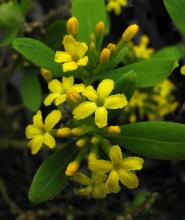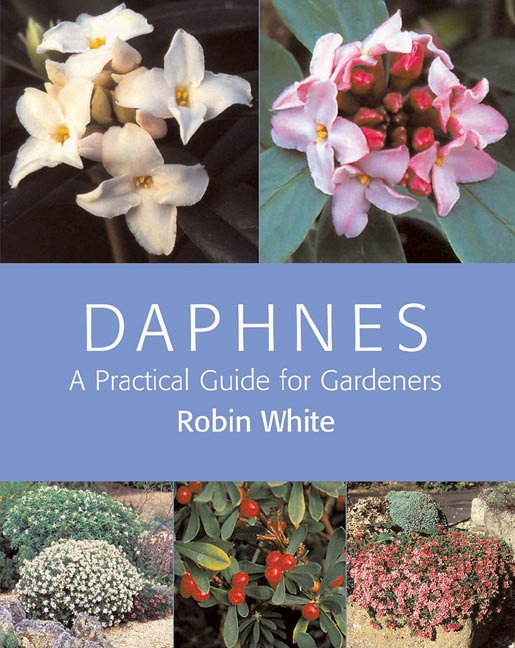Daphnes: A Practical Guide for Gardeners, Robin White, Timber Press, Portland, Oregon (January 3, 2006); 224pp, 160 color photos, 2 line drawings, hardcover; publisher's price: $34.95; Amazon price: $34.95.
When I first became interested in alpine plants 15 years ago I read about Daphnes. They sounded fascinating but difficult, ready to die suddenly without warning. I had never seen one, but apparently they were beautiful, tidy, and compact plants perfect for rock gardens. More than anything else, however, it was the idea of their wonderful fragrance that tempted me to flirt with failure. I decided to try one, then another… The ones that I tried proved to be surprisingly easy to grow in western Pennsylvania where I garden. Our climate can be difficult for many rock gardeners. For example, it gets very hot and humid in the summer, one year can be too wet, the next year too dry, which interferes with the growth of many alpines. The winters are peculiar—sometimes it will not get very cold, but sometimes it will suddenly drop to 0°F after a few days of drizzle. Our climate is anything but dependable and regular, or one of gradual transitions. I eventually discovered that, fortunately, Daphnes are mostly not alpines, but more plants of the mountains, loving rocks and good drainage, but otherwise not so picky about climate that they can’t thrive in Pittsburgh. Information on their culture was a little difficult to find however, so my approach so far has been by trial and error.
 Robin White’s 2006 book Daphnes: A Practical Guide for Gardeners, helps eliminate much of the guesswork of growing Daphnes successfully. It is a complete gardening guide. The first chapter is devoted to a brief history on the taxonomy and morphology of Daphne. Descriptions of all Daphne species that are currently in cultivation follow, as well as descriptions of Daphne hybrids. Of special interest to me was the chapter covering propagation of Daphnes by seed, at which I have had mixed success, but am now encouraged to make further attempts, as I now have an idea of what I did wrong in the past.
Robin White’s 2006 book Daphnes: A Practical Guide for Gardeners, helps eliminate much of the guesswork of growing Daphnes successfully. It is a complete gardening guide. The first chapter is devoted to a brief history on the taxonomy and morphology of Daphne. Descriptions of all Daphne species that are currently in cultivation follow, as well as descriptions of Daphne hybrids. Of special interest to me was the chapter covering propagation of Daphnes by seed, at which I have had mixed success, but am now encouraged to make further attempts, as I now have an idea of what I did wrong in the past.
Also excellent are the detailed instructions for vegetative propagation, such as layering, cuttings, and grafting. The detailed section on grafting was especially interesting. Having found Daphnes quite easy to root as cuttings I am encouraged to try grafting, following White’s instructions about the proper selection of rootstock and description of the grafting process itself, accompanied by photos and diagrams. Reading it, one feels it would be hard to go wrong, given the amount of useful information conveyed in the pages of White’s book.
Further chapters on cultivation in the garden and under cover, in a cold frame or alpine house/poly tunnel, are enlightening, with thorough recommendations about soil composition and plant siting, pruning, and shaping plants. The final chapters on pests and the various ways Daphnes are incorporated into garden schemes are also helpful.
The book is generously illustrated with beautiful color photographs, mostly created by the author, revealing the wide variety in growing habit of the various species and hybrids, as well as the wide variety of flower shape, color, and size of the different cultivars within a given species.
One criticism of this otherwise fine book is that, like so many gardening guides written in the UK, hardiness advice is not always reliable. In the case of my personal experience of the genus Daphne, I have found them to be hardier than stated. Many would agree that questioning hardiness advice can be considered a general rule for books not written by or for the Midwestern USA gardener; it is a small criticism, but one to keep in the back of one’s mind. Otherwise, Daphnes: A Practical Guide for Gardeners is a good investment for anyone with a desire to grow these rewarding plants successfully.
Paul Bowden works as a sculptor and scientific illustrator in Pittsburgh, PA. He grows native plants and rock garden plants adaptable without supplemental watering to the western Pennsylvania climate, Daphnes included.

